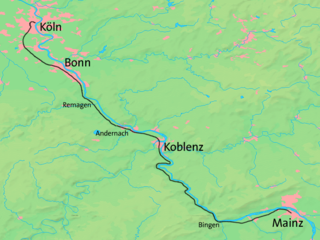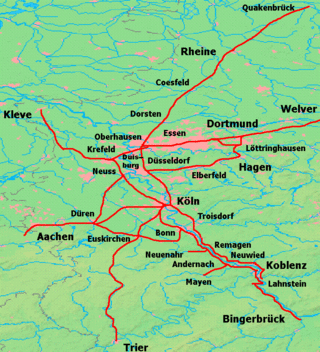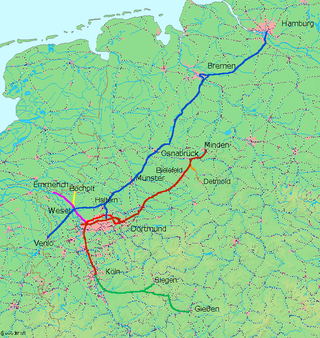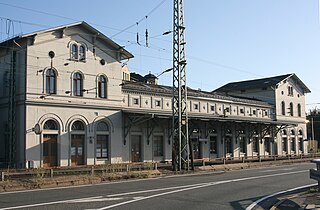
The Lahn is a 245.6-kilometre-long (152.6 mi), right tributary of the Rhine in Germany. Its course passes through the federal states of North Rhine-Westphalia (23.0 km), Hesse (165.6 km), and Rhineland-Palatinate (57.0 km).

Lahnstein is a verband-free town of Rhein-Lahn-Kreis in Rhineland-Palatinate, Germany. It is situated at the confluence of the Lahn with the Rhine, approximately 6 kilometres (3.7 mi) south of Koblenz. Lahnstein was created in 1969 by the merger of the previously independent towns of Oberlahnstein on the south side of the Lahn and Niederlahnstein on the north side. In 2020, it had a population of 18,030.

The West Rhine railway is a famously picturesque, double-track electrified railway line running for 185 km from Cologne via Bonn, Koblenz, and Bingen to Mainz. It is situated close to the western (left) bank of the river Rhine and mostly aligned to allow 160 km/h operation between Cologne and Koblenz and between Bingen and Mainz. Line speed between Koblenz and Bingen is restricted by the meandering nature of the Rhine Gorge, a UNESCO World Heritage Site.
The Bonn–Oberkassel train ferry was a German train ferry operated by the Rhenish Railway Company from 1870 to connect its right and left Rhine railways. It was the last of six train ferries to begin operations across the Rhine in Germany and the second to last to close.

The East Rhine Railway is a major, double-track, electrified railway line, running along the right bank of the Rhine from Cologne to Wiesbaden. The 179-kilometer (111.2 mi)-long line forms two Deutsche Bahn routes. Route 465 extends from Cologne to Koblenz, via Troisdorf, Bonn-Beuel, Unkel, and Neuwied. From Koblenz, Route 466 extends to Wiesbaden, via Rüdesheim am Rhein. Together with the Taunus railway, the line is used by Stadt-Express line SE-10 of the Rhine-Main Transport Association, which runs from Frankfurt to Koblenz and Neuwied.

The Taunus Railway is a double-track electrified railway line, which connects Frankfurt and Wiesbaden, Germany. It is 41.2 km long and follows the course of the Main on its north side, running quite close to it in some places. Its first stage was opened in September 1839 and is thus the oldest railway line in the German state of Hesse and one of the oldest in Germany. Today it is used by Regional-Express trains between Frankfurt and Wiesbaden and the trains of line S1 of the Rhine-Main S-Bahn between Frankfurt-Höchst and Wiesbaden. Between Frankfurt Hbf and Frankfurt-Höchst, they run on the line of the former Hessian Ludwig Railway.

The Hessian Ludwig Railway or HLB with its network of 697 kilometres of railway was one of the largest privately owned railway companies in Germany.

The Rhenish Railway Company was along with the Cologne-Minden Railway Company (CME) and the Bergisch-Märkische Railway Company (BME) one of the railway companies that in the mid-19th century built the first railways in the Ruhr and large parts of today's North Rhine-Westphalia.

The Lahntal railway or Lahn Valley Railway is a railway line between Niederlahnstein in the German state of Rhineland-Palatinate to Wetzlar in Hesse, partly following the Lahn valley (Lahntal). Its western terminus was originally in Oberlahnstein. Trains now mostly operate between Koblenz and Gießen. The line was opened by the Nassau Rhine and Lahn Railway Company and the Nassau State Railway between 1858 and 1863 and is one of the oldest railways in Germany.
The Bingerbrück–Rüdesheim train ferry was operated as a train ferry from 1862 to 1900 across the Rhine between Bingerbrück now in the German state of Rhineland-Palatinate and Rüdesheim now in the state of Hesse.

The Hindenburg Bridge was a railway bridge over the Rhine between Rüdesheim in the German state of Hesse and Bingen-Kempten state of Rhineland-Palatinate, named in 1918 after Field Marshal Paul von Hindenburg, later German President. The bridge was put in service in 1915, destroyed in the Second World War and never rebuilt.

The Nahe Valley Railway is a two-track, partially electrified main line railway in the German states of Rhineland-Palatinate and Saarland, which runs for almost 100 kilometres along the Nahe. It was built by the Rhine-Nahe Railway Company and connects Bingen am Rhein on the Left Rhine line with Saarbrücken. It was opened between 1858 and 1860 and is one of the oldest railways in Germany. The section south of Bad Kreuznach is part of the regionally important transport corridor between the two major cities of Mainz and Saarbrücken.

The Deutz–Gießen railway is a line between Deutz and Gießen that was built from the late 1850s to connect the Ruhr and the Rhine-Main area, now parts of the German states of North Rhine-Westphalia and Hesse. The line still exists, but little traffic still runs over the whole of the historical route. It now forms the northern part of the Sieg Railway between Cologne Deutz station and Betzdorf, the Heller Valley Railway between Betzdorf and Haiger and the southern part of the Dill Railway between Haiger and Gießen.

Koblenz-Ehrenbreitstein station is the only station on the right (eastern) bank in the city of Koblenz in the German state of Rhineland-Palatinate. It is on the East Rhine railway at the foot of the Ehrenbreitstein hill in the Ehrenbreitstein district, next to the Rhine.

The Aar Valley Railway is a 53.7 km long line between Wiesbaden, the capital of the German state of Hesse, and Diez in Rhineland-Palatinate. From 1985 to 2009, the southern end was operated as a heritage railway with historic trains. The Hessian part of the line is heritage-listed. Currently, two bridges are unusable and several sets of points are defective and need to be repaired. Its northern end is operated with draisines.

Wiesbaden Ost (east) station is situated on the Frankfurt–Wiesbaden line in the German state of Hesse. It was opened as part of the Taunus Railway, which was opened in 1839/40. The station was opened as part of the last stage of construction of the line to Wiesbaden and was opened on 19 May 1840.

Rüdesheim (Rhein) station is in the town of Rüdesheim am Rhein in the German state of Hesse on the East Rhine Railway. It is on the western edge of the town, separated from the Rhine only by federal highway B 42. The entrance building is a double storey stucco building in a neoclassical style. It is now one of the cultural monuments listed in the UNESCO World Heritage Site of the Upper Middle Rhine Valley. The station is classified by Deutsche Bahn as a category 5 station.

Niederlahnstein station is, along with Oberlahnstein and Friedrichssegen, one of three stations in the town of Lahnstein in the German state of Rhineland-Palatinate. It is a separation station on the East Rhine Railway and the Lahn Valley Railway and is located in the Niederlahnstein district and forms a public transport hub for the Rhine-Mosel-Lahn area.

Oberlahnstein station is, along with Niederlahnstein and Friedrichssegen, one of three stations in the town of Lahnstein in the German state of Rhineland-Palatinate. It is a through station with 3 platform tracks on the East Rhine Railway and is located in the Oberlahnstein district. The adjacent former freight depot is now a brownfield site.

Eltville station is the railway station of Eltville in the Rheingau in the German state of Hesse, on the East Rhine Railway from Wiesbaden to Koblenz. It is classified by Deutsche Bahn as a category 5 station.